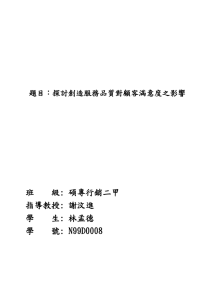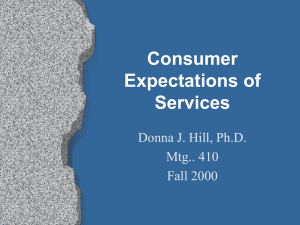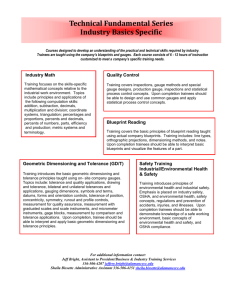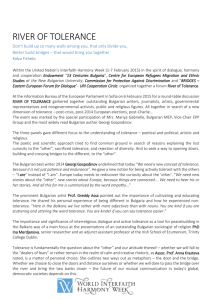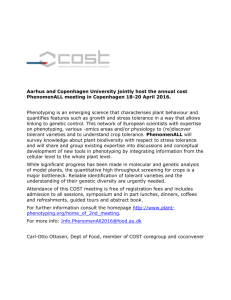zones-text - California State University, Sacramento
advertisement
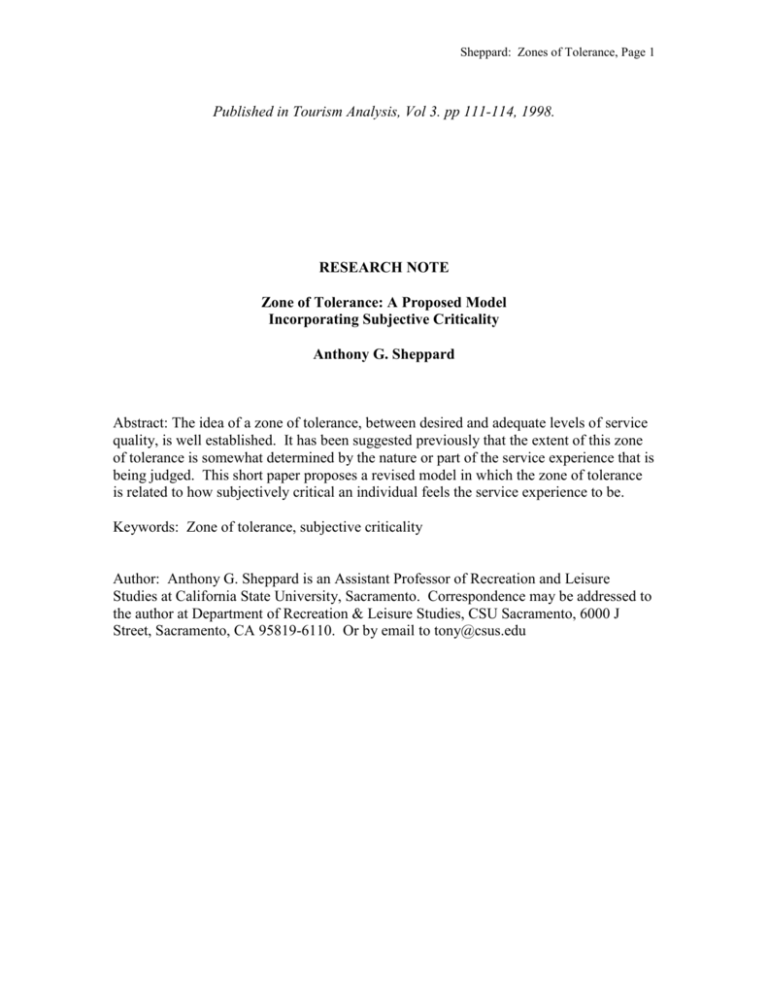
Sheppard: Zones of Tolerance, Page 1 Published in Tourism Analysis, Vol 3. pp 111-114, 1998. RESEARCH NOTE Zone of Tolerance: A Proposed Model Incorporating Subjective Criticality Anthony G. Sheppard Abstract: The idea of a zone of tolerance, between desired and adequate levels of service quality, is well established. It has been suggested previously that the extent of this zone of tolerance is somewhat determined by the nature or part of the service experience that is being judged. This short paper proposes a revised model in which the zone of tolerance is related to how subjectively critical an individual feels the service experience to be. Keywords: Zone of tolerance, subjective criticality Author: Anthony G. Sheppard is an Assistant Professor of Recreation and Leisure Studies at California State University, Sacramento. Correspondence may be addressed to the author at Department of Recreation & Leisure Studies, CSU Sacramento, 6000 J Street, Sacramento, CA 95819-6110. Or by email to tony@csus.edu Sheppard: Zones of Tolerance, Page 2 RESEARCH NOTE As part of their gap analysis approach to measuring consumer perceptions regarding service experiences, Parasuraman, Zeithaml and Berry referred to a zone of tolerance between desired and adequate levels of service (c.f. Parasuraman, Zeithaml & Berry, 1985; Berry & Parasuraman, 1991; Zeithaml, Berry & Parasuraman, 1993). While noting certain circumstances that affected the relative magnitude of that zone of tolerance, no single model was proposed that would incorporate these subjective circumstances and, subsequently, how critical a given experience was to an individual. This short paper is intended to suggest such an inclusive model. In their related work, leading to development of the SERVQUAL scale (see also Parasuraman, Zeithaml & Berry, 1988), the same authors identified five dimensions of the service experience: reliability, responsiveness, assurance, empathy, and tangibles. (While it is recognized that this dimensionality has since been questioned, amended and/or criticized by several other researchers, even by the original authors, these alternative viewpoints and findings are neither within the scope of this very brief proposition or material to the basic premise of it.) Berry and Parasuraman (1991) subsequently referred to the reliability dimension as the outcome dimension of the service encounter and the other four dimensions as the process dimensions of the service encounter. The authors also stressed the relative importance of the outcome dimension over the process dimensions, as reported by subjects of their research. Figure 1 represents their conceptualization of the relative position and size of the zone of tolerance with regard to expected levels of service performance, respective to both outcome and Sheppard: Zones of Tolerance, Page 3 process dimensions. It can be seen that the more important outcome dimension coincides with higher performance expectations and a narrower zone of tolerance than does the process dimension. [Insert Figure 1 about here] The authors further identified nine factors that would cause the expectation levels and zones of tolerance to vary (Berry & Parasuraman, 1991; Zeithaml, Parasuraman & Berry, 1993). These included such factors as transitory service intensifiers (temporary special needs) and explicit service promises (contracts, guarantees, advertising) that might alter both expectations and tolerance. A New Model It is the purpose of this short paper to propose a single model that represents these various phenomena in an inclusive manner. Rather than simply distinguishing between the outcome and process dimensions (regardless of their exact makeup), this dichotomy might be replaced with a continuum that reflects how critical a given expectation is in relation to a performance evaluation, subjective to the individual and circumstance. For the purposes of this monologue, this measure is termed subjective criticality and is, essentially, an importance rating. The diagonal, dotted lines in Figure 2 are intended as a bridging point in the development of the proposed model and stress the relative size and position of the zones of tolerance illustrated in Figure 1. The proposed model can be seen in Figure 3. Here, the lower axis represents subjective criticality (decreasing to be Sheppard: Zones of Tolerance, Page 4 consistent with the placement of the dichotomous dimensions in Figures 1 and 2), or the level to which the entire product or service encounter, or components thereof, are critical to the individual consumer’s evaluation. It is this situationally specific measure of importance that seems to reflect the differences between the earlier dimensions while accommodating the effects of the suggested factors that might cause variation. [Insert Figures 2 & 3 about here] It is conjectured that as subjective criticality decreases, expected performance levels decrease and the zone of tolerance widens. Conversely, as subjective criticality increases, expected performance levels increase and the zone of tolerance narrows. This is in keeping with the earlier models (Berry & Parasuraman, 1991). The extremes in Figure 3 represent easily conceivable situations. At the upper left extreme (Point A) might be found a situation wherein the service component is perceived to be so necessary that the desired level of performance is the only acceptable level, with no lower level of performance considered adequate. For example, a prospective hotel guest may be quite flexible in terms of the features (size, location, etc) of a guestroom (relatively low subjective criticality), but may not be at all tolerant of a situation in which no room is available (extreme high subjective criticality – Point A). Point B (and points further to the right) might represent a situation in which a particular component is considered somewhat desirable, but for which the complete lack of that component is acceptable (an intermediate level of subjective criticality). Similarly, Point C might represent a situation Sheppard: Zones of Tolerance, Page 5 in which a specific component does not even rate a positive level of desirability (extreme low subjective criticality). It is worth noting that the model could be adapted to accommodate a trait that is considered detrimental in some way. In such a case, the desired level might be the complete lack of that component, while an acceptable level might represent some positive representation of that trait. The measurement of such a trait would be negative (or else the model would be inverted) and, for example, Point A in Figure 3 would be analogous to a situation in which the complete lack of the trait was of critical importance and the only acceptable result. Thus, a higher level of performance would represent the lower level of the negatively perceived trait. Also, the model and associated arguments would be similarly applicable to goods products and hybrids. Implications The proposed model appears to incorporate the features and ideas of the earlier propositions, while allowing for greater flexibility and generalization. It would be possible to test such a model within an existing data set that included both desired and adequate performance levels and a measure of the relative importance of the corresponding components. It may also be possible to combine such research with existing importance-performance models. By testing this proposition, both existing and future research may better enable us to serve our various user groups. We intuitively associate higher performance ratings with greater success in our respective endeavors. However, it is clearly possible for an individual to rate one experience more highly than another in terms of performance while Sheppard: Zones of Tolerance, Page 6 rating it lower in terms of satisfaction, given that their expectations of the two experiences are not necessarily consistent. Similarly, any difference in subjective criticality may also be found to affect perceptions of satisfaction and quality and, given this knowledge, may require even higher levels of performance to accommodate higher expectations and/or reduced tolerances. Any increase in understanding regarding the extent to which tourists and other consumers tolerate deviations from their expectations can only assist in increasing satisfaction levels. This model would suggest the extreme importance of accurate consumer based data regarding expectations for those products and components that are subjectively perceived to be the most important. In practice, there may be no room for error and no tolerance for underestimation of such expectations. Sheppard: Zones of Tolerance, Page 7 References Berry, L. L. & Parasuraman, A. (1991). Marketing services: Competing through quality. New York: The Free Press. Parasuraman, A, Zeithaml, V. A., & Berry, L. L. (1985). A conceptual model of service quality and its implications for future research. Journal of Marketing, 49(Fall), 41-50. Parasuraman, A, Zeithaml, V. A., & Berry, L. L. (1988). SERVQUAL: A multiple-item scale for measuring consumer perceptions of service quality. Journal of Retailing, 64(1), 12-40. Zeithaml, V. A., Berry, L. L., & Parasuraman, A. (1993). The nature and determinants of customer expectations of service. Journal of the Academy of Marketing Science, 21(1), 1-12.



